Are there black spots on your drywall that might be Mold? Looking for the best ways to Get rid of Mold from your drywall walls or ceilings?
In this guide you will learn:
- How to recognize black mold on drywall or ceiling,
- Common causes and how to remove black mold from drywall,
- How to prevent black mold from starting on drywall and spreading further.
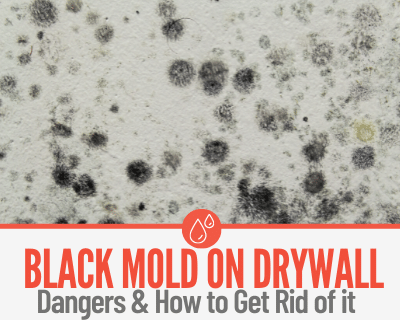
Black mold grows and spreads extremely quickly on drywall and can show up when even small amounts of moisture are present.
It’s extremely important to Get rid of Black Mold on Drywall as soon as you start noticing it to prevent serious mold damage!
What Does Black Mold On Drywall Look Like
Black mold on drywall generally looks like a circular black stain on your drywall.
While the color can vary from a dark gray to dark black depending on how long the mold has been there, it is normally black often with white fuzz.
Black mold usually will have a fuzzy texture, similar to a cotton ball, when it is first growing. Fuzzy spores are less common in older black mold.
Black Mold that has been sitting for a long time will look more like a flat black stain than fuzzy spores.
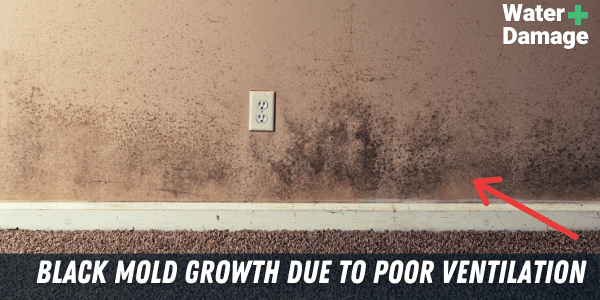
Black Mold patches on drywall usually grow in a circular shape that are denser toward the middle.
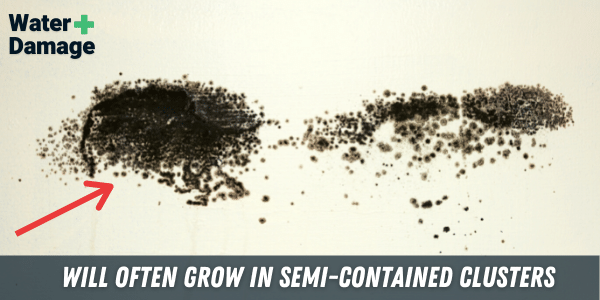
The thickest part of the black mold will be closest to the cause and hardest to eliminate.
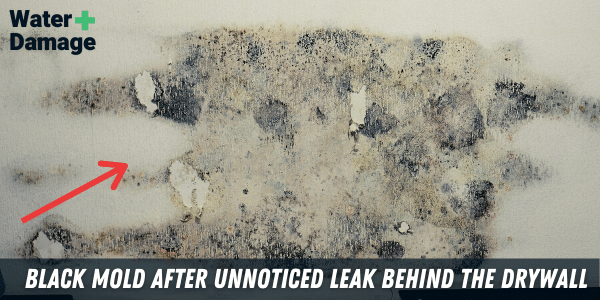
Most Common Causes of Black Mold On Drywall
In general, any location that is damp, dark, and has a food source is a hot spot for black mold to grow. Couple this with limited air flow and a leaky pipe and you are sure to find mold on your drywall.
Black mold grows quickly when moisture is present, so it is important to keep a close eye on any place that has flooded or encounters regular steam.
Even just a slight amount of moisture over time can perpetuate mold growth.
Drywall is a perfect place for mold as it is organic and holds water. The paper on the outside of drywall is a common place for water damage which can lead to mold growth.
Drywall in bedrooms, basements, bathrooms, kitchens, sheetrock, and drywall ceilings are all common places to find black mold.
These are all areas that are prone to flooding, constant steam, moisture from exterior walls, and daily contact with water.
Living in a humid environment can also cause excess mold to grow in your home.
Be sure to monitor drywall frequently for any new mold growth.
Is Black Mold On Drywall Toxic & Dangerous?
Black mold found on drywall can be hazardous to your health. The most common problem associated with mold on your drywall is having an allergic reaction to it.
Sneezing, coughing, and watery eyes can all happen quickly after breathing in any black mold spores.
Eyewear and face masks are especially important to avoid breathing it in.
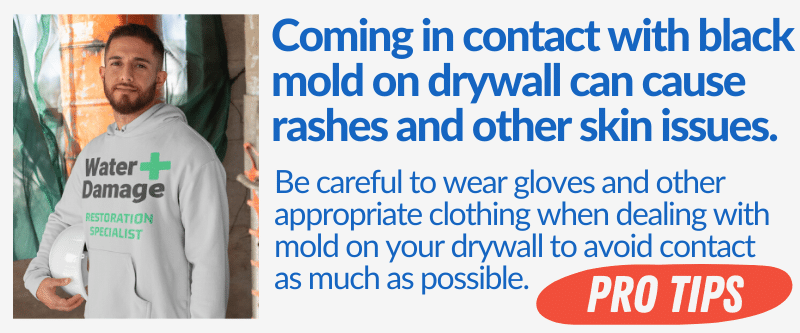
Consistent exposure to black mold could cause lasting respiratory issues as well as mold poisoning.
Black Mold poisoning can cause cough, sinusitis, and wheezing. It is imperative to take care of the black mold on drywall quickly and efficiently whenever it is found
Along with health problems, structural damage can happen if mold is left too long. Mold will eat away at the organic material in drywall and will weaken the wall itself.
Is Dried/Dead Black Mold on Drywall still Dangerous?
Black mold is alive and can spread when there is moisture present. If a patch of black mold has been dried out, the black mold is technically not growing and has died.
To figure out if the black mold on your drywall is dead or not, use a broom to brush it off the wall.
If the black mold is powdery, dry, and flakes off of the wall it is dead. Dead black mold can be just as hazardous because it can easily brush off into the air.
Black Mold on drywall can become active again if moisture is reintroduced to the area.
The only way to eliminate black mold for good is to get rid of the moisture and the mold entirely.
Should I Replace Drywall Covered With Black Mold?
Black mold grows well in drywall because it is porous ,made of organic material and can hold water well – perfect material for black mold to flourish.
Black mold Can even eat through your drywall and cause structural damage.
If Uncontained ,black mold can spread quickly through drywall causing very significant damage.
If the wall itself is soft to the touch, there is too much mold to clean off – the drywall needs to be replaced. Remove the affected drywall and let any framing or remaining drywall dry thoroughly before you replace the drywall.
When mold growth has gotten this far, it is often better to call a professional instead of doing it yourself.
A professional will be able to assess the extent of the damage and ensure that all drywall is safe and secure.
Black mold on Drywall?
Call 844-488-0570 for a Risk Free estimate from a Licensed Mold Remediation Specialist in your area.
We Can Help Get rid of the Black mold & Prevent it from Returning.
How To Get Rid of Black Mold On Drywall
What Kills Black Mold On Drywall?
Once you have determined that the mold has not permanently damaged your drywall, it can cleaned off with simple household items. Mix a cleaning solution of one of the following options:
- 1 part vinegar and 1 part water. Vinegar has both antibacterial and anti fungal properties that kill the black mold well. It can also penetrate deep into the black mold to kill the root of the problem.
- 1 cup bleach to 1 cup water. Chlorine in bleach works well at killing surface b;acl mold but it will not kill mold that has grown deep into your drywall. Bleach should only be used if there is a small amount of black mold and you are sure it is only on the surface.
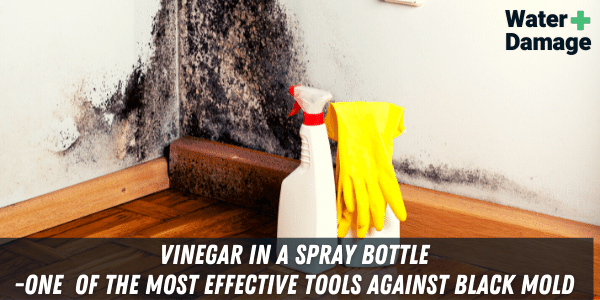
Before removing any black mold, it is important to note that you should avoid touching the molds and breathing in the spores as much as possible.
Removing the black mold as quickly as possible can help limit exposure to molds. Wearing gloves or a face mask while removing and cleaning mold infected areas can also help avoid encountering the mold or breathing it in.
Sealing off rooms and vents near the mold will also help stop the spread of spores throughout your house.
Bring in as much ventilation as possible when cleaning up mold. This can be done by opening a door or window or adding an air purifier.
Mold cleanup can be done with common things you already might have at home.
Here is a list of things you may need:
- Protective gear (minimum of breathing mask and gloves)
- Plastic sheets to seal off doors and vents
- Tape to seal off doors and vents
- Stiff bristled brush
- Spray bottle
- Vinegar or bleach (see below)
- Disinfecting wipe or rag
- Plastic zip-lock bag to dispose of cleaning materials
- Fan
- Optional primer and paint to cover stains and seal drywall
1.Stop The Moisture
Black Mold can only grow on drywall when there is moisture. Find the source of the water and you will likely be able to stop the mold from spreading further in your walls.
Culprits could be simple things like steam from showers to major issues like flooding.
Moisture can be stopped by making sure the area is well ventilated, fixing any leaks or flooding, and exterior walls have been properly insulated.
2.Spray The Black Mold on Drywall With Your Cleaning Solution
Spray all visible black mold on the drywall thoroughly and let it sit for 10 to 15 minutes. Make sure that you spray the entire surface of the drywall that has mold spores.
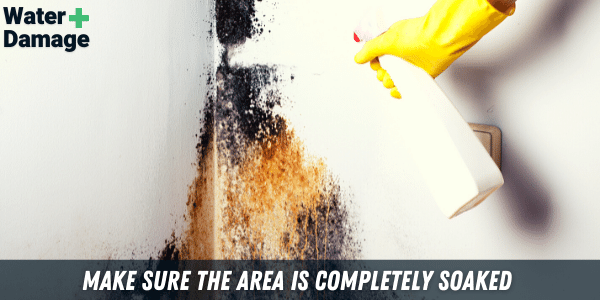
3.Put On Protective Gear And Seal Any Airways
Black mold is especially dangerous when breathed in. Use a face mask or respirator before cleaning up mold to avoid breathing in any spores that get into the air.
Gloves, long sleeved shirts, and closed toed shoes will also help prevent coming in contact with the mold.
Sealing doorways and vents will prevent the black mold spores from spreading into other areas in your home. Always open a window so there is ventilation while working.
4.Scrub The Black Mold With A Brush
Using a brush with stiff bristles will breakup and remove the mold from drywall effectively. Scrub the mold in a circular motion until it has all come off of the drywall.
Once all the mold has been removed, use either a wet rag or a disinfecting wipe to clean any residue off the wall.
Dispose of any and all materials used for cleaning in a sealed plastic bag, this will prevent mold from growing in other areas in and around your house.
5.Let It Dry
In order to prevent the black mold from coming back, the drywall must be completely dry.
Use a fan, a dehumidifier, or open a window to make sure there is plenty of ventilation to dry the room.
6.Repair/Re-paint Drywall if needed
Some black mold patches can leave stains on the drywall even after they are removed. Stains look similar to the mold itself but will not be wet or fuzzy.
Painting over the stain is an effective way to both fix the wall and prevent further mold.
Use a primer that contains a black mold blocking agent. This will kill any tiny bits of black mold left over as well as cover up the stain before painting.
Preventing Future Black Mold Growth on Drywall
Mold can be prevented when moisture near drywall is controlled. Ensuring that there is good ventilation in a bathroom, sufficient insulation on exterior walls, and cleaning up well after flooding will prevent mold from growing.
Drywall can be sealed with paint to prevent the growth of black mold. Once a wall has been thoroughly cleaned and dried, paint the wall with latex based paint.
Painting over black mold without cleaning and removing it will not kill the mold. The drywall must be treated first, then can be painted over.
Adding a mold inhibitor to paint can also be helpful in prevention. Many primers are also mold resistant and can add one more layer of protection against mold on your drywall walls and ceilings.
When To Call A Professional
Small Patches of Black mold on Drywall can be removed easily as a DIY Project.
If there is extensive black mold growth on your drywall walls or ceilings it’s extremely important to get rid of it right away to mitigate any further damage or health problems that could occur.
If black mold is allowed to spread or is not removed effectively it can completely take over your home and wreak havoc.
Calling a professional to properly eliminate larger black mold infestations in drywall most of the time is crucial.
They will be able to take care of the mold efficiently and completely, while also helping mitigate the return of mold.
We have Mold Remediation Specialists that can help Find the Source of the black mold on drywall, Remove it, Prevent it from returning & Repair any Mold Damage.
For Disasters of all Sizes,available in 95% of the USA
